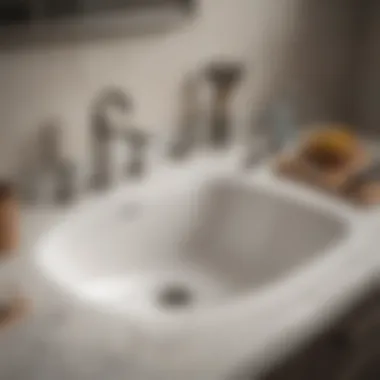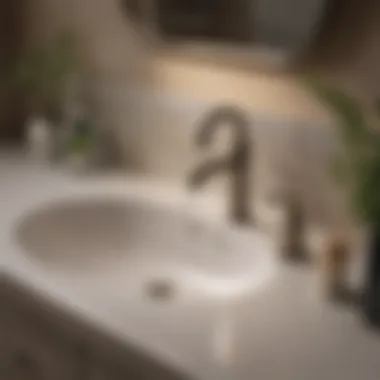Effective Solutions for Slow Draining Bathroom Sinks


Intro
A bathroom sink that fails to drain efficiently is more than an inconvenience. It can lead to water buildup and even potential plumbing issues if not addressed promptly. Understanding the reasons behind this problem is essential for effective resolutions. Homeowners often encounter various factors contributing to the slowdown of their sink drainage, ranging from hair clogs to more complex plumbing issues.
This article aims to explore the common causes of slow draining sinks, practical troubleshooting methods, and preventive measures to avoid future problems. Through this guide, you will learn how to accurately diagnose the situation and recognize when a professional plumber's expertise is needed.
Causes of Bathroom Sink Drainage Issues
1. Clogs
Clogs are the most common reason for a slow-draining sink. Hair, soap residue, toothpaste, and other debris can accumulate in the sink drain over time. This build-up creates blockages, preventing normal water flow.
2. Improper Installation
Sometimes, issues arise from initial installation mistakes. Pipes that are too narrow or improperly sloped can impede drainage. This problem may not be obvious initially, but it can lead to persistent drainage issues.
3. Ventilation Problems
Plumbing systems rely on proper ventilation to function efficiently. If vents are blocked or improperly installed, they can create a vacuum effect that restricts drainage. This leads to slow draining and bubbling sounds during drainage.
4. Aging Plumbing
Older plumbing systems may suffer from corrosion, mineral build-up, or other age-related issues. These factors can restrict the size of pipes and decrease water flow.
Troubleshooting Your Bathroom Sink
Step 1: Assess the Situation
Begin by observing the flow of water. Does it drain slowly under normal conditions? Is there a gurgling sound? Understanding the symptoms can guide your troubleshooting efforts.
Step 2: Check for Obvious Clogs
Remove any visible debris from the sink. You can also use a plunger to dislodge potential clogs. Make sure to cover the overflow drain to create adequate pressure.
Step 3: Use Baking Soda and Vinegar
A natural remedy involves pouring half a cup of baking soda down the drain, followed by half a cup of vinegar. Let it sit for about 30 minutes, then flush with hot water. This can sometimes clear minor clogs effectively.
Step 4: Inspect the Trap
The trap, located under the sink, is prone to collecting debris over time. Place a bucket underneath, remove the trap, and clean out any residue that may have accumulated.
Step 5: Consider Professional Help
If these methods do not yield results, it may be time to call a plumber. Professional assistance is a wise move for complex drainage issues.
Preventive Measures
Regular Maintenance
Perform regular maintenance by cleaning your drain periodically. Avoid letting hair and debris go down the sink, and consider using a sink strainer.
Proper Installation
Ensure that any plumbing work follows best practices, including proper pipe sizing and slope.
"Proactive maintenance is key to preventing drainage issues from becoming major headaches."
Addressing Aging Pipes


If your plumbing is old, consider inspecting and possibly replacing outdated pipes. Modern materials can provide improved drainage and reduce future problems.
Ending
Understanding the root causes of drainage issues allows homeowners to take proactive measures. By diagnosing problems accurately and employing effective solutions, you can maintain optimal function for your bathroom sink. Remember, in more complex cases, professional intervention is not just advisable; it can save time and money in the long run.
Prelims to Drainage Issues
Importance of Efficient Drainage
Efficient drainage in a bathroom sink is fundamental not only for its functionality but also for maintaining hygiene. Poor drainage can create a breeding ground for bacteria, which is harmful to health. When water accumulates, it may also lead to foul odors that make the bathroom unpleasant. Furthermore, a slow-draining sink may indicate larger plumbing issues lurking beneath the surface. Timely attention can prevent these from escalating.
Common Indicators of Drainage Problems
Recognizing the signs of drainage problems early can save both effort and expense. Here are some common indicators:
- Slow Drainage: Water accumulates in the sink rather than flowing freely.
- Unpleasant Odors: A foul smell could signal trapped waste or stagnant water.
- Gurgling Sounds: Unusual noises while draining can indicate air trapped in the pipes.
- Frequent Clogs: Regular blockages suggest there is an underlying issue that needs addressing.
"Early detection of drainage issues can prevent extensive and costly repairs down the line."
By being attentive to these signs, one can take action before the situation worsens. Understanding and resolving these problems can contribute to a more efficient and healthy bathroom space.
Understanding Bathroom Sink Mechanisms
Understanding the mechanisms behind bathroom sink functionality is crucial for effective troubleshooting and maintenance. Recognizing how a sink operates can help in pinpointing the reasons why it might not drain properly. Efficient understanding of these mechanisms can also facilitate quicker resolutions to problems when they arise, ultimately saving time and resources.
Components of a Bathroom Sink
A bathroom sink consists of several key components. Each of these parts plays a vital role in the overall functionality:
- Sink Basin: This is the visible part where water collects. Its shape and size can impact how well it drains, especially if it is designed with a shallow slope.
- Faucet: The faucet is responsible for supplying water. Any malfunction here can contribute to excess water in the sink.
- Drain Assembly: This includes the drain plug and the drain opening. If this assembly is clogged or not functioning well, water will accumulate in the basin.
- P-Trap: This is a bend in the plumbing below the sink that holds water and prevents sewer gases from entering the home. It is also a common site for clogs due to debris accumulation.
- Vent Pipe: While not directly part of the sink, the vent pipe allows air into the plumbing system. A blockage here can create negative pressure, hindering drainage.
Recognizing these components is essential. When issues arise, knowing what to inspect can guide you toward a solution.
How Water Drains in Sinks
The drainage process in bathroom sinks generally follows a clear path:
- Water Enters the Basin: When the faucet is turned on, water flows into the sink basin.
- Gravity and Angle: The angle of the sink is designed so that water naturally moves toward the drain through gravitational force.
- Drain Opening: Following this path, water flows through the drain opening and heads toward the P-Trap below.
- P-Trap Functionality: Here, water pools slightly, helping to block smelly gases from coming up the pipes. Ideally, as new water enters the drain, it pushes the old water through the plumbing system.
- Discharge: Finally, the water exits the home through the drain line, ideally moving freely without obstruction.
To conclude, comprehending the mechanisms of bathroom sinks enhances the ability to address drainage issues. By understanding how each part contributes to the overall functionality of the sink, it becomes easier to identify problems and implement effective solutions.
Common Causes of Poor Drainage
In understanding why a bathroom sink does not drain properly, it is crucial to recognize common causes of poor drainage. Identifying these issues early can prevent minor problems from escalating into major repairs. Each cause can affect the efficiency of drainage, contribute to clogs, and result in an unpleasant user experience. Addressing these causes can lead to better water flow and, ultimately, enhance the longevity of plumbing systems.
Clogs from Hair and Soap Residue
A significant contributor to poor drainage is clogging from hair and soap residue. When hair mixes with soap or other products, it can form a dense mass that easily clogs the drain. Over time, this can lead to a blockage that obstructs water flow. Regularly removing hair from the drain after use can significantly reduce this risk. To clear minor clogs, consider using a mixture of vinegar and baking soda, which can help dissolve soap deposits without harsh chemicals.
Debris Accumulation in the P-Trap
Another common issue arises from debris accumulation in the P-trap, a curved pipe located beneath the sink. Its design helps to prevent sewer gases from entering the home, but it can also trap material such as food particles, grease, and other debris. Regular inspection and cleaning of the P-trap are important to maintain proper drainage and prevent further obstructions. To clear the P-trap, unscrew and remove it, then clean it with a brush and warm water. Always ensure to place a bucket underneath to catch any residual water.
Issues with Ventilation
Ventilation is often overlooked but plays a vital role in drainage efficiency. Poor venting can trap air and create pressure in the plumbing system, affecting water movement. Vents allow air to enter the plumbing system, enabling water to flow smoothly. If you notice gurgling sounds or slow drainage, it may indicate a venting issue. Consulting a plumbing professional can help diagnose and recommend repairs if venting systems become obstructed.
Pipe Damage or Misalignment
Finally, damaged or misaligned pipes can lead to poor drainage. Older plumbing systems can experience wear and shift over time, causing pipes to become misaligned. This can impede the flow of water and make sinks drain slowly. If you suspect that your pipes are damaged, checking for leaks or unusual noises can be a start. Repairing or replacing misaligned pipes can restore proper drainage and prevent future concerns.


Regular maintenance and being aware of common plumbing issues can help homeowners avoid the frustration of slow-draining sinks.
Diagnosing Drainage Issues
Diagnosing drainage issues effectively is a critical step in solving problems with a bathroom sink not draining well. Understanding the underlying causes can save time and money. It allows homeowners to address minor issues before they escalate into more significant plumbing problems. Identifying the source of drainage difficulties early can prevent damage not only to the sink but also to the entire plumbing system.
Visual Inspection Techniques
A thorough visual inspection is essential in diagnosing sink drainage problems. Start by observing the sink basin and surrounding areas. Check for obvious signs of water pooling or slow drainage. Look under the sink for leaks or signs of water damage. Also inspect the faucet and any exposed pipes for corrosion or blockages.
Some specific things to observe include:
- The state of the sink strainer or pop-up plug. Ensure it is free of hair or residue.
- Water level in the sink; if it takes too long to drain, a blockage might be present.
- Odors emanating from the sink may indicate decay or clogs.
- Check the overflow holes, if applicable, as debris could block them.
Being observant can highlight red flags that require more thorough investigation.
Utilizing Plumbing Tools for Diagnosis
In addition to visual inspection, using plumbing tools can enhance diagnosis. A plunger may help identify clogs by applying force to the drain, which can often dislodge minor blockages.
A plumbing snake or auger is another valuable tool. It can reach deeper blockages in the pipes which are not easily visible. These tools are effective for:
- Clearing hair and soap scum from the P-trap or drain line.
- Determining the location and nature of a blockage by following the path of the snake.
For those less experienced in plumbing, investing in a simple drain camera can provide visual evidence of what is obstructing the flow. With good lighting and a clear view, it simplifies the diagnosis substantially.
Recognizing Warning Signs of Serious Problems
Not all drainage issues are minor. Certain signs could indicate a more complex plumbing problem. Homeowners should take note of any drastic changes, such as:
- Frequent backups or slow draining in multiple fixtures.
- Unusual gurgling sounds from the sink or adjacent plumbing.
- Visible water damage or dampness around the plumbing infrastructure.
- Bad odors that persist despite cleaning efforts.
"Recognizing these symptoms early can potentially save homeowners a significant amount on repairs and prevent further structural damage."
If any of these warning signs are present, further investigation is warranted. Ignoring signs can lead to more severe issues, requiring professional intervention and costly repairs.
Troubleshooting Techniques
Simple Drain Cleaning Methods
The first step in troubleshooting is often to attempt simple drain cleaning methods. These methods are accessible to most homeowners and can effectively remove minor clogs.
- Hot Water: Pouring hot water down the drain can dissolve soap and grease build-up.
- Baking Soda and Vinegar: This classic method uses a cup of baking soda followed by a cup of vinegar. After sealing the drain for about 15 minutes, flush with hot water to clear debris.
- Boiling Water: Simply boiling water and slowly pouring it down the drain can help to clear minor clogs caused by food residue or soap.
These methods require minimal tools. They are cost-effective and can significantly improve the flow in the sink.
Safe Usage of Chemical Drain Cleaners
While chemical drain cleaners can be effective, they must be used with caution. Understanding their proper usage ensures safety and effectiveness.
- Read Instructions: Always follow the manufacturer's instructions on the label.
- Choose Safe Products: Opt for environmentally friendly cleaners when possible.
- Wear Protective Gear: Safety glasses and gloves are essential when handling these chemicals.
Using chemical cleaners should be seen as a last resort. Frequent use can damage pipes over time. It is important to avoid mixing different cleaners, as this can create harmful reactions.
Using a Plumber's Snake Effectively
A plumber's snake, or drain auger, can help reach clogs that simple methods cannot address. This tool consists of a flexible metal coil that can maneuver through pipes.
- Insert Properly: Insert the snake into the drain slowly, ensuring it goes in smoothly.
- Rotating Motion: Rotate the handle to allow the coil to catch debris, pulling it back with controlled motion.
- Cleaning: After retrieving the clog, clean the snake to avoid further clogs.


Using a plumber's snake requires some technique, but mastering it can alleviate persistent drainage issues.
"Troubleshooting is essential. Simple methods can solve many issues before seeking further help."
In summary, employing troubleshooting techniques is vital in resolving the frustrating problem of sinks not draining properly. Whether trying basic cleaning methods, using chemical cleaners sensibly, or deploying a plumber's snake, these strategies can empower homeowners to take control of their plumbing issues.
When to Seek Professional Help
Understanding when to call a plumber is crucial for homeowners experiencing drainage issues. Often, small problems can be resolved with basic troubleshooting. However, there are times when the complexity of plumbing systems makes it necessary to hire a professional.
Identifying Complex Plumbing Issues
Complex plumbing problems can arise suddenly or develop over time. Recognizing these issues is key to preventing more severe damage. Some signs include:
- Frequent Clogs: If you repeatedly experience clogs after clearing them, this may indicate a deeper problem in the plumbing system.
- Uneven Drainage: If other sinks or drains in your home are also slow, this could signal a blockage in the main sewer line.
- Persistent Bad Odors: Foul smells from drainage systems may indicate build-up or decaying material in pipes.
- Water Backups: If water backs up into other drains, it points to a potential issue beyond localized clogs.
These symptoms require careful examination. Due to the intricate nature of plumbing, skilled professionals utilize specialized tools and experience to identify the root cause of the problem. Ignoring these signs might lead to costly repairs later.
Understanding Cost-Benefit of Professional Services
Engaging a plumbing expert might seem like an unnecessary expense at first. However, the cost-benefit analysis often reveals its value. Here are several considerations:
- Expertise: Professionals diagnose issues accurately, which saves time and money compared to repeated DIY attempts that may fail.
- Proper Tools: Specialized equipment allows professionals to resolve problems efficiently, often in less time than an untrained individual could.
- Long-term Solutions: Rather than temporary fixes, professionals provide lasting solutions that reduce the likelihood of recurring issues.
- Safety: Plumbing systems can involve hazardous materials or conditions. Professionals ensure that repairs are done safely and correctly.
Addressing plumbing issues early can save considerable expense. Investing in a qualified plumber might mitigate further damage and expensive repairs down the road.
"When faced with persistent plumbing issues, do not hesitate to consult an expert. Timely intervention can prevent minor issues from escalating into major headaches."
When considering a plumber, research their reputation. Ensure they are licensed and experienced in the specific issues you face. Choosing the right professional can offer peace of mind and restore functionality to your home's plumbing system.
Preventive Maintenance Strategies
Preventive maintenance is crucial for ensuring that your bathroom sink functions effectively over time. Many individuals overlook the importance of routine care until a significant issue arises, leading to costly repairs or frustrations. By instituting preventive strategies, homeowners can enhance the longevity of their plumbing systems while reducing the frequency of major obstacles. Proactive maintenance includes habits and tools that keep the drains clear and operational. The benefits of these strategies are numerous, including improved flow, reduced risk of complex plumbing issues, and overall satisfaction with home infrastructure.
Regular Cleaning Routines
Establishing a regular cleaning routine for your bathroom sink is vital. This routine should involve weekly inspections and cleaning of the sink and drain. Use a simple mixture of vinegar and baking soda once a month to aid in removing buildup without harmful chemicals. Here’s a detailed checklist for ensuring effective cleaning:
- Clear away all debris from the sink, including hair and soap residues.
- Flush the drain with hot water after each cleaning to prevent buildup.
- Consider using a plunger if you notice slow drainage during your inspections.
All these steps will help maintain a smooth drainage system.
Installing Drain Screens
Another effective strategy involves installing drain screens. Drain screens act as barriers, catching larger particles that might otherwise enter the plumbing system. Simple mesh screens can prevent hair and larger debris from accumulating in the P-trap. When choosing a drain screen, consider the size and ease of cleaning; a poorly fitting screen can create more problems. Regularly remove the screen and clean it to ensure optimal performance.
Educating Household Members
Education is a key component in preventive maintenance strategies. Informing all household members about proper practices can significantly reduce issues. Here are a few fundamental points to convey:
- Avoid disposing of grease or large food particles in the sink.
- Emphasize the importance of using drain covers or screens.
- Teach everyone how to perform basic cleaning tasks, fostering a sense of shared responsibility.
Incorporating these measures can create a culture of care and attentiveness toward the home’s plumbing systems.
Remember: Consistent preventive maintenance significantly reduces future hassles, streamlining overall household management.
By implementing these preventive strategies, homeowners can mitigate potential drainage problems and extend the lifespan of their bathroom sink and plumbing systems.
Closure
Summary of Key Takeaways
- Identification: Recognizing symptoms, such as slow draining and unpleasant odors, serves as the first step in addressing drainage issues.
- Diagnosis: Inspecting the sink with basic tools helps in identifying if the problem stems from clogs, P-trap debris, or pipe misalignment.
- Solutions: Implementing simple solutions, from regular cleaning routines to using suitable drain cleaners, can prevent further complications.
- Professional Help: Knowing when to consult a plumber can save time and resources, especially for complicated plumbing issues.
- Preventive Maintenance: Establish practices such as household education about proper disposal methods and installing screens to minimize clogging.
Final Thoughts on Maintenance and Repair
As a homeowner, investing time and effort into maintaining bathroom drainage systems can offer both peace of mind and financial prudence. Always remember, staying vigilant about potential drainage concerns can keep your bathroom functioning efficiently for years to come.







